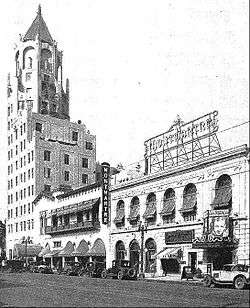Café Montmartre
Café Montmartre (now Montmartre Lounge) was a restaurant and nightclub on Hollywood Boulevard at Highland Avenue[1] in Hollywood, Los Angeles, California, US. Opened in 1923, it became a "worldwide center for celebrity and nightlife" during the 1920s and a place where tourists would visit to try to break into Hollywood.

History
In 1919, Charles E. Toberman bought the property at 6763 Hollywood Boulevard, and three years later, built a real estate office on the lot.[2] The building, run by Meyer & Holler, included a first floor bank and Café Montmartre on the second floor. Café Montmartre was the first popular nightclub on the boulevard after Adolph 'Eddie' Brandstatter opened it in 1923. Given the dramatic growth of the American film industry in Hollywood at the time, it became a "worldwide center for celebrity and nightlife" during the 1920s.[3] Gregory Paul Williams, author of The Story of Hollywood: An Illustrated History, describes it as the first successful café in Hollywood, stating that it became "the most publicized cafe in the country, where a bottle of booze was a sure thing, as was gambling in the back room".[4]
The venue's decline began in 1929 after Brandstatter opened the Embassy Club which drew away clientele from the Cafe Montmartre. He declared bankruptcy in 1932, and subsequently sold the Montmartre. The second floor space later housed the Lee Strasberg Institute before it became the present-day Club Day After, which features the Montmartre Lounge,[5] a private parties' bar, its signage being just the letters "ML".[1] A convenience store has replaced the first floor bank.[6] Red Skelton's Hollywood Walk of Fame star for his work on radio is in front of the 6763 building.[7]
Function

It was frequented by some of the top stars and figures in the business at the time, including John Barrymore, Bebe Daniels, Adolphe Menjou, Rudolph Valentino, Bessie Love, Mary Astor, Charlie Chaplin, Fatty Arbuckle, Lew Cody, Douglas Fairbanks, and Tom Mix, and writers and businesspeople such as Rupert Hughes, Peter B. Kyne and William Randolph Hearst.[4][8] It became a symbol of glamor across the United States and gained renown as a place where one could get a ticket to stardom, due to the many film bosses and stars who frequented the venue. Tourists from around the country visited daily, hoping to be spotted and to make their name as a film star. Some were lucky; Don Terry was discovered by Fox screenwriter Charles Francis Coe at the restaurant, who gave Terry his business card and invited him to the Fox lot for a screen test.[9] Terry was later signed as the lead in the 1928 film Me, Gangster, directed by Raoul Walsh.[9]
Bruce Cabot was maitre d' at Montmartre,[5] and its orchestra was led by Vincent Rose and Jackie Taylor.[10] Friday night was "celebrity" night. There was plenty of dancing, and even floor shows with dancers. In addition, men who sat at the "bachelors' table" made themselves available to ladies who wanted to dance at lunch. Special events included a dance contest, which Clara Bow won, Joan Crawford danced the Charleston atop a table, and Rudolph Valentino's tango is mentioned with honors.[5] Hip flasks were common during the prohibition era, and a bootlegger was available, too. On Wednesday and Friday nights, the cafe was frequented by columnist Louella Parsons looking for news.[1]
Architecture and fittings

Built in the style of an Italian Renaissance palazzo,[5] the two story structure featured Spanish tiling and grilled doors decorated with Mexican wrought-iron.[11] Imported carpeting and chandeliers filled the Romanesque interior.[6]
References
| Wikimedia Commons has media related to Café Montmartre. |
- Perry, Charles (April 14, 2011). "Brandstatter brought the party to old Hollywood". Los Angeles Times. Retrieved 26 November 2014.
- Palmer, Edwin Obadiah (1938). History of Hollywood. E. O. Palmer. p. 166.
- "Café Montmartre: Hollywood's First Nightclub". Millenniumhollywood.net. Archived from the original on 27 April 2015. Retrieved 25 November 2014.
- Williams, Gregory Paul (2005). The Story of Hollywood: An Illustrated History (Print). S.l: BL Press, Storyofhollywood.com. p. 124. ISBN 978-0-9776299-0-9.
- Alleman, Richard (6 March 2013). Hollywood: The Movie Lover's Guide: The Ultimate Insider Tour of Movie L.A. Crown Publishing Group. p. 21. ISBN 978-0-8041-3777-5.
- Bailey, Mark; Hemingway, Edward (26 August 2014). Of All the Gin Joints: Stumbling Through Hollywood History. Chapel Hill, North Carolina: Algonquin Books of Chapel Hill. p. 14. ISBN 978-1-56512-593-3.
- "Red Skelton". IMDb.
- "From All Corners of the Earth They Come to Hollywood's Boulevard of Hope and Tragedy". The New Movie Magazine. 1929. pp. 74–5. Retrieved 26 November 2014.
- Bailey, Vernon (January 1929). Embarrassment. Photoplay. pp. 74, 105. Retrieved November 24, 2014.
- Starr, Jimmy (1 January 2001). Barefoot on Barbed Wire: An Autobiography of a Forty-year Hollywood Balancing Act. Scarecrow Press. p. 56. ISBN 978-0-8108-3941-0.
- Zollo, Paul (2011). Hollywood Remembered: An Oral History of Its Golden Age. Taylor Trade Publications. p. 369. ISBN 978-1-58979-603-4.